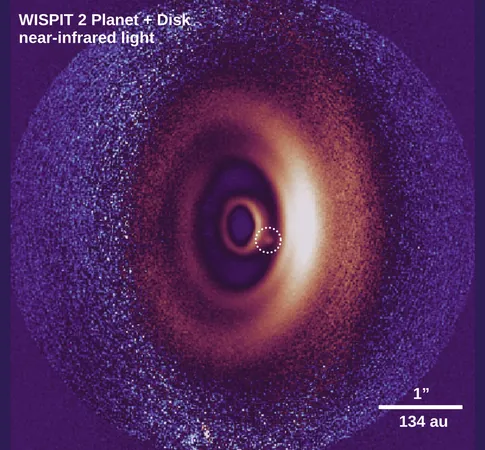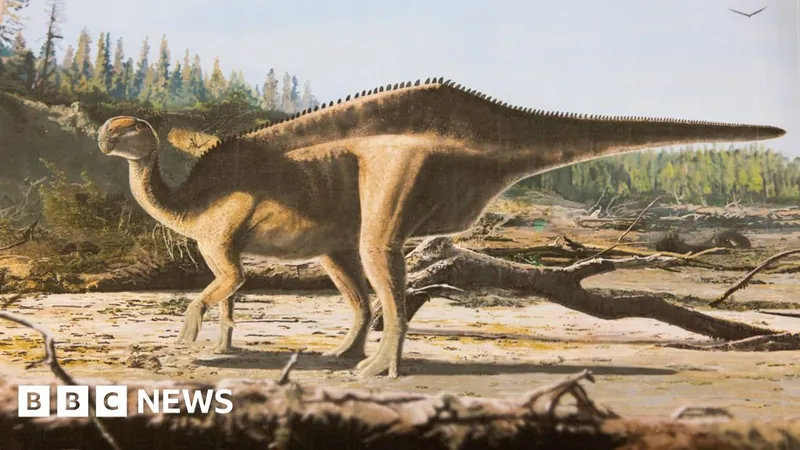
Meet WISPIT 2b: The Baby Planet That Outshines Jupiter!
2025-08-28
Author: William
Astronomers Unveil a Cosmic Marvel
In an astonishing breakthrough, astronomers have discovered a brand-new type of planet outside our solar system that is already making waves—it’s bigger than Jupiter! Meet WISPIT 2b, a colossal baby planet born only about 5 million years ago, which is practically an infant in cosmic terms, and it is an astonishing five times larger than the gas giant Jupiter.
An Unprecedented Discovery
This remarkable find marks the first clear detection of a baby planet developing within a swirling disc of dust and gas adorned with multiple rings around a young star, significantly younger than our own Sun. This discovery not only gives us a glimpse into planetary birthing processes but also provides groundbreaking insights into how young planets influence their nebulous surroundings.
A Game-Changing Research Expedition
Lead researcher Richelle van Capelleveen from Leiden University in the Netherlands exclaimed, "We did not expect to find such a spectacular system. This discovery could serve as a crucial benchmark for years to come!" The research team, consisting of scientists from several institutions including the University of Galway and the University of Arizona, made this unexpected find while conducting unrelated observational studies.
What Exactly Is An Exoplanet?
For those unacquainted, exoplanets are planets that lie outside our solar system. Some of these celestial wanderers, called rogue planets, float through space unattached to any star. As of now, astronomers have confirmed the existence of over 5,800 exoplanets, though estimates suggest billions more are out there waiting to be discovered.
The Role of Protoplanetary Disks
Stars are born when gas and dust collapse under gravity, creating protoplanetary disks—the nursery of planets. These disks rotate around young stars, and leftover materials become the building blocks for new planets. Think of these disks as cosmic construction sites, where planets are sculpted from the raw materials of the universe.
WISPIT 2b: A Unique Prodigy
WISPIT 2b isn’t just any baby planet—it’s the first ever discovered that has created a distinct, bright gap in the protoplanetary disc around its star. This discovery represents a significant leap in our understanding of how planetary systems form. The planet orbits its star at an impressive distance, roughly 56 times farther than the Earth is from the Sun.
The Striking Images That Captured Our Imagination
Thanks to the European Southern Observatory's Very Large Telescope situated in the Atacama Desert, stunning images of WISPIT 2b were captured, showcasing this young planet amidst its dusty cradle. The ESO refers to these protoplanetary discs as the "birthplaces of planets," underscoring the significance of this discovery.
Looking Back at Earth's Origins
Just like our own solar system began around 4.5 billion years ago, WISPIT 2b's protoplanetary disc likely mirrors those early days. Researchers aspire to uncover how our solar system might have looked during its infancy by studying these developing planetary systems.
A Bright Future for Planetary Science
The implications of this extraordinary find are vast. Christian Ginski, a study coauthor, noted, "Capturing an image of these forming planets is incredibly challenging and provides insights that could explain the vast diversity we observe among older exoplanet systems. I predict this system will attract significant interest among colleagues studying planet formation in years to come." Two related research papers detailing this groundbreaking discovery have been released in the Astrophysical Journal Letters.









 Brasil (PT)
Brasil (PT)
 Canada (EN)
Canada (EN)
 Chile (ES)
Chile (ES)
 Česko (CS)
Česko (CS)
 대한민국 (KO)
대한민국 (KO)
 España (ES)
España (ES)
 France (FR)
France (FR)
 Hong Kong (EN)
Hong Kong (EN)
 Italia (IT)
Italia (IT)
 日本 (JA)
日本 (JA)
 Magyarország (HU)
Magyarország (HU)
 Norge (NO)
Norge (NO)
 Polska (PL)
Polska (PL)
 Schweiz (DE)
Schweiz (DE)
 Singapore (EN)
Singapore (EN)
 Sverige (SV)
Sverige (SV)
 Suomi (FI)
Suomi (FI)
 Türkiye (TR)
Türkiye (TR)
 الإمارات العربية المتحدة (AR)
الإمارات العربية المتحدة (AR)